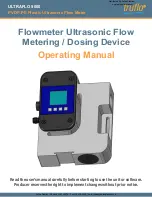
10
AW T 210 |
2- W I R E CO N D U C T I V I T Y, P H/O R P, P I O N T R A N SM I T T ER | O I/AW T 2 10 - EN R E V. C
…4 Hazardous area considerations
…Hazardous area relevant information
ATEX/IECEx
Intrinsic safety
II 1G Ex ia IIC T4 Ga when used with appropriate barriers.
Figure 8 Intrinsic safety – ATEX/IEC
Ingress protection classification
IPX6
Ambient temperature range
–20 °C =< Ta =< 60 °C
Input parameters of AWT210 transmitter: HART
Maximum voltage
Ui =
30 V
Maximum input current
Ii = 100 mA
Maximum power
Pi =
0.8 W
Internal inductance
Li = 3.3 mH
Internal capacitance
Ci = 0.56 nF
Output parameters of sensor: 4-electrode
Maximum open-circuit voltage
Uo =
11.8 V
Maximum short-circuit current
Io = 11.8 mA
Maximum output power
Po = 36 mW
Maximum inductance
Lo =
1 H
Maximum capacitance
Co =
1.5 µF
Output parameters of sensor: 2-electrode
Maximum open-circuit voltage
Uo =
11.8 V
Maximum short-circuit current
Io = 11.8 mA
Maximum output power
Po = 36 mW
Maximum inductance
Lo =
1 H
Maximum capacitance
Co =
1.5 µF
Output parameters of sensor: toroidal
Maximum open-circuit voltage
Uo =
11.8 V
Maximum short-circuit current
Io = 11.8 mA
Maximum output power
Po = 36 mW
Maximum inductance
Lo =
1 H
Maximum capacitance
Co =
1.5 µF
Output parameters of sensor: pH
Maximum open-circuit voltage
Uo =
11.8 V
Maximum short-circuit current
Io = 11.8 mA
Maximum output power
Po = 36 mW
Maximum inductance
Lo =
1 H
Maximum capacitance
Co =
1.5 µF
NOTICE
Parameters apply to entire system inclusive of cables.
Each specified electrical parameter must be applied
individually and in combination. Do not exceed the
maximum values when applying the electrical parameters
individually or in combination.
Specific conditions of use
1 For the aluminium enclosure for EPL Ga –
the AWT210 enclosure option (code position 8, option 2 –
see Data Sheet
) contains aluminium and is
considered to present a potential risk of ignition by impact
or friction. Care shall be taken into account during
installation and use to prevent impact or friction.
2 For the aluminium enclosure –
for areas subject to explosive dust atmospheres the painted
surface of the AWT210 may store electrostatic charge and
become a source of ignition in applications with a low
relative humidity <~30% relative humidity where the painted
surface is relatively free of surface contamination such as
dirt, dust, or oil. Guidance on protection against the risk of
ignition due to electrostatic discharge can be found in IEC TS
60079-32-1. Cleaning of the painted surface shall only be
done in accordance with the manufacturer’s instructions
(see page 7).
3 For the Lexan enclosure –
for areas subject to explosive gas atmospheres the Lexan
enclosure AWT210 may store electrostatic charge and
become a source of ignition in applications with a low
relative humidity <-30% relative humidity where the Lexan is
relatively free of surface contamination such as dirt, dust, or
oil. Guidance on protection against the risk of ignition due to
electrostatic discharge can be found in IEC TS 60079-32-1.
Cleaning of the surface shall only be done in accordance with
the manufacturer’s instructions (see page 7).
4 For aluminium and Lexan enclosures –
the AWT210 shall not be used where UV light or radiation
may impinge on the enclosure or the window of the
enclosure.
5 For Non –Incendive applications the sensor can be used only
in non-flammable materials.
ia
ia
Hazardous area
Non-hazardous area
Zone 2
Transmitter
Associated apparatus
providing intrinsically
safe [ia] outputs











































